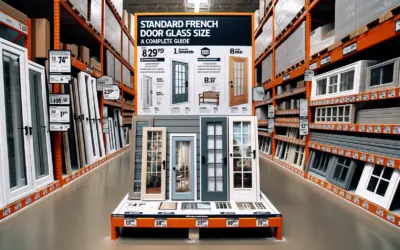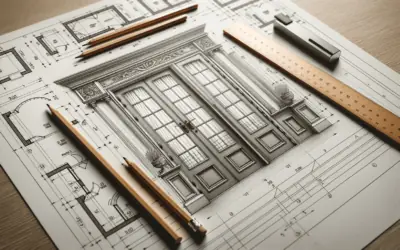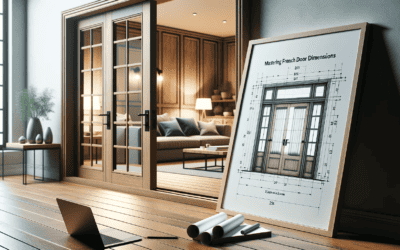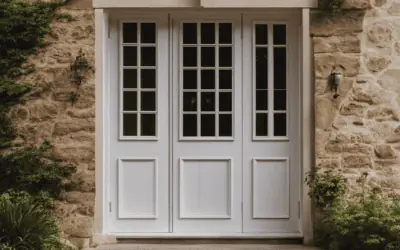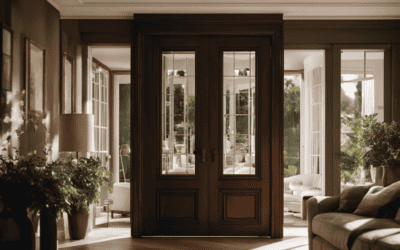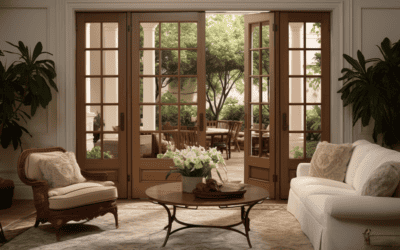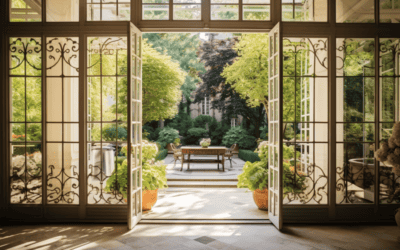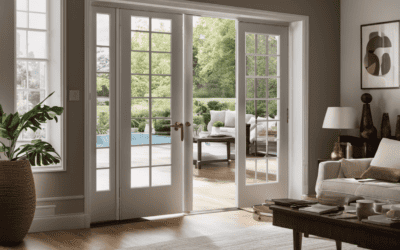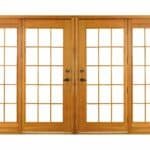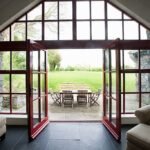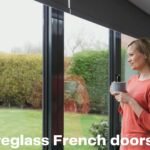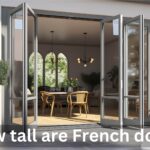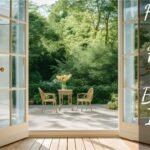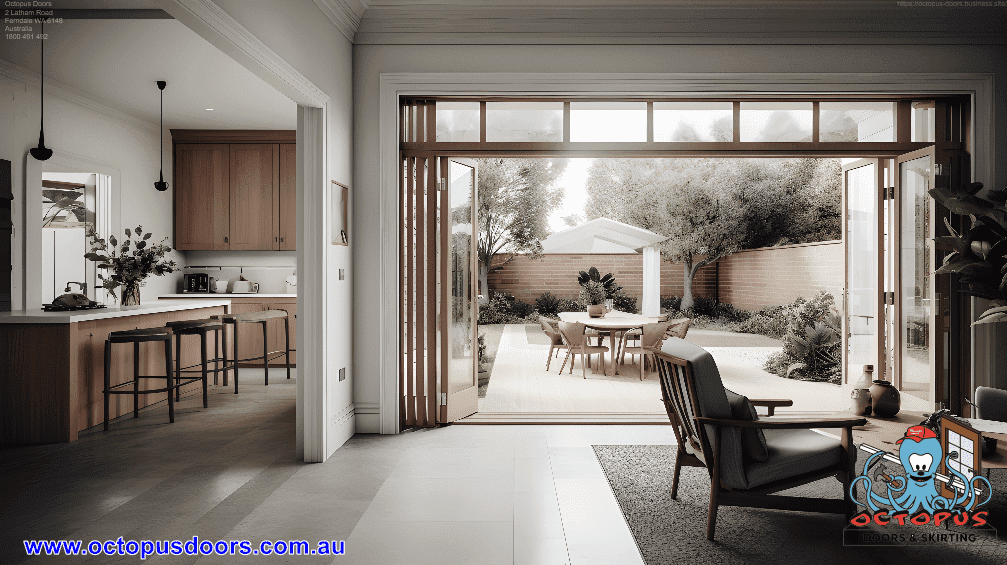
Yes, you can absolutely transform bifold doors into elegant French doors. This easy DIY endeavour requires minimal materials and expertise, as the door is being repurposed. You’ll breathe new life into your space with an elegant touch by simply following a few steps.
Let’s explore the three different methods to achieve this transformation:
- Install Hinges: Start by removing the bifold door from its closet and track, then unscrew and remove the track and associated hardware. As the doors lack doorframe hinges, ensure they’re still attached at a corner for pivotal support. Attach six hinges to the door panels – you may even be able to reuse some of the existing bifold door hinges!
“Changing bifold doors to French doors adds a touch of class and elevates the look of any room.” – Sarah Beeney, Renowned Property Expert and Interior Designer.
- Use Mending Braces and a Magnetic Catch: Instead of hinges, attach mending braces on the doors, and use a magnetic catch to keep the doors closed. Use scrap 1×3 wood for affixing the metal plate to the door.
- Employ Bifold Hardware: A third alternative is utilizing bifold hardware instead of hinges. Lay out the bifold door on sawhorses or the floor and remove the existing hinges. Connect the door panels with bifold hardware to accomplish the French door look.
No matter your chosen method, converting bifold doors into French doors considerably enhances a room’s appearance. These stylish doors offer a more upscale and sophisticated vibe compared to traditional bi-folds, sure to leave a lasting impression on all who enter.
Key Takeaways:
- Converting bifold doors to French doors is an easy DIY project with three different methods.
- Installing hinges, using mending braces and a magnetic catch, or employing bifold hardware are viable options.
- French doors add a touch of elegance and sophistication, elevating the appeal of any room.
Now, it’s time for you to make the switch – are you ready to embrace the charm and style of French doors?
Understanding the Fundamentals of Bifold Doors
Bifold doors, also known as folding or accordion doors, offer a seamless, unobstructed opening created by synchronising hinged panels that slide and fold away. Ideal for homeowners looking to enhance the airiness and openness of their living spaces, these unique doors can effortlessly connect indoor and outdoor areas or easily grant access to a closet’s contents.
These innovative doors operate on the concertina principle, with panels simultaneously sliding and folding as the door is opened. Hinged together, the panels glide on runners that are discreetly positioned in the floor and the upper lintel or beam of a doorway, pulling open from the centre to reveal an uninterrupted view of what lies beyond. Bifold doors can be designed to fold in or out, allowing you to customize their functionality based on your space requirements.
Bifold doors are available in various profiles, offering countless design possibilities, adding character to any plain opening. When paired with a sturdy track, heavy bifold doors smoothly move away from the closet’s centre, granting a full interior view. However, it’s essential to ensure accurate installation, as door designs may need to be adjusted to accommodate the often irregular shape of apertures. Runners come in various designs, focusing on being as unnoticeable as possible.
As noted by an interior design expert Jane Thomas, “Bifold doors have become a popular choice for homeowners seeking to create a more open and connected living experience.” Frequently used to bridge indoor and outdoor spaces – think living rooms and patios, kitchens and gardens – bifold doors facilitate the comfortable flow of activity and conversation. They’re also a fantastic closet option, providing easy access to the belongings inside.
Bifold doors present a stylish, practical solution for those looking to enhance the ambience and accessibility of their home with their seamless functionality and impressive adaptability. To ensure the full potential of these doors is realized, consider consulting with an experienced professional for proper installation and design guidance.
Grasping the Basics of French Doors
French doors are an elegant solution to maximize daylight and transform the ambience of your living space. These stylish doors boast full-length rectangular glass panels framed by sleek mullions that define their iconic look. French doors deliver impressive proportion and architectural interest and are suitable for a wide array of design themes – from cozy country cottages to sophisticated modern homes.
Hailing from France, these doors were originally designed as windows providing access to balconies. Over time, their exceptional ability to flood a room with sunlight led to their evolution into doors. French doors serve multiple purposes, such as patio, front, and interior doors.
The allure of French doors lies in their distinct advantages. They:
- Seamlessly connect indoor and outdoor spaces.
- Amplify the natural light entering your home.
- Enhance your home’s aesthetic appeal.
- Provide easy access to balconies, patios, and gardens.
While French doors might have a higher price tag than standard exterior sliding doors or basic solid interior doors, the investment is worthwhile for homeowners who appreciate their unique benefits.
Typically, French doors are installed as entrances to gardens, patios, or balconies, replacing the past’s narrowly framed aluminium sliding doors. With various configurations available, such as in-swing, out-swing, or sliding French door units, a solution suits every need.
Occasionally, French doors are used as front entrance doors. However, in such cases, homeowners must consider their requirements for additional features like screening.
As an eminent architect and interior designer, Bobby McAlpine, once said, “French doors create a permeable threshold between the inside and the outside that works as well – if not better – than any window.” French doors are undoubtedly a wise investment in enhancing your living spaces.
Comparing the Design and Functionality of Both Door Types
While French doors boast timeless elegance with their outward-swinging design, bi-fold doors offer a modern, space-saving alternative. Understanding the differences between these two options will help you make an informed decision that caters to your needs and enhances your living space.
French Doors: Classic and Versatile
Ideal for patios, balconies, and interiors where natural light is a must, French doors feature a traditional design that swings outward. With a variety of materials available, including solid wood, vinyl, fibreglass, and wood with clad exteriors, French doors tend to be pricier than standard exterior sliding doors and basic solid interior doors. Yet, their user-friendly nature allows for quick and easy access to outdoor areas. Renowned architect Frank Lloyd Wright once said, “The longer I live, the more beautiful life becomes,” much like the enduring appeal of French doors.
Bifold Doors: Modern and Space-saving
Opt for bifold doors if you’re seeking a contemporary solution to limited space. These doors consist of multiple panels hinged together, which slide open and fold or stack neatly off to one side. Bifold doors outshine French doors in terms of space-saving potential, making them perfect for closets, laundry rooms, and pantries. Better equipped to withstand the elements, bifold doors also lend a sleek, modern aesthetic to any room.
French Doors vs. Bifold Doors: Key Takeaways
- French doors are ideal for exterior and interior spaces where natural light is desired, while bifold doors are better suited for closets and small rooms.
- French doors swing outward, providing easy use and quick access to outdoor spaces; bifold doors slide open and fold to one side, saving space.
- French doors come in various materials like solid wood, vinyl, and fibreglass, while bifold doors are typically found in more modern materials.
Interior designer Nate Berkus said, “Your home should tell the story of who you are and be a collection of what you love.” So, when considering French doors versus bifold doors, factor in your personal style, available space, and functional requirements. After all, the perfect door is out there waiting to enhance and elevate your living space.
| Feature | Bifold Doors | French Doors |
|---|---|---|
| Structure | Multiple folding panels | Pair of hinged doors |
| Opening mechanism | Fold and slide | Swing open |
| Space requirement | Minimal, fold compactly | Need space to swing open |
| Views | Can provide larger views | Smaller uninterrupted views |
| Material options | Wood, aluminium, uPVC | Wood, aluminium, uPVC, steel |
| Energy efficiency | Good, depending on the sealing | Good, depending on the sealing |
| Installation complexity | Moderate to high | Low to moderate |
| Cost | Typically more expensive | Typically less expensive |
| Security | Good, depending on the locking system | Good, depending on the locking system |
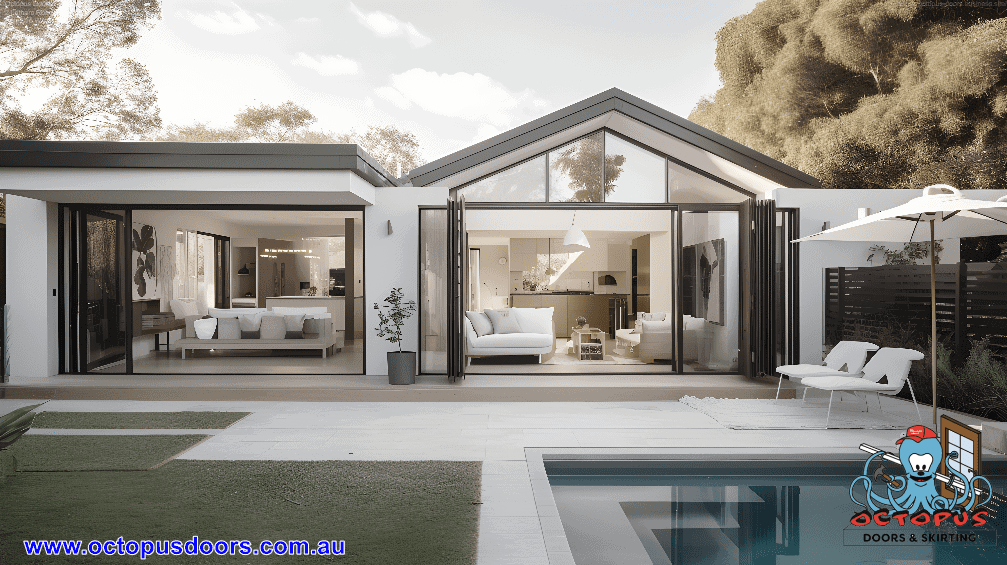
Pros and Cons of Bifold Doors
Bifold doors offer a versatile and stylish solution. However, like any other home improvement option, they come with their own set of pros and cons. Let’s explore the benefits and drawbacks of these doors in detail.
The Upsides of Bifold Doors
- Wide Open Spaces: Bifold doors can be fully retracted, essentially transforming a whole wall into an open gateway to your patio or garden. This feature adds a touch of sophistication to your living space and facilitates a seamless indoor-outdoor flow.
- Compact Convenience: In tighter spaces where a typical door wouldn’t suffice, bifold doors can serve as an effective alternative, conserving space while maintaining functionality.
- Material Variety: Homeowners have a plethora of options when it comes to bifold door materials, including aluminium, wood, and UPVC. Aluminium is particularly popular due to its strength and durability compared to UPVC.
- Lightweight and User-friendly: Thanks to innovative technology and modern materials, bifold doors are both easy to operate and maintain. Cleaning these doors is also a breeze, with full access to the frame and glass from both the inside and outside.
The Downsides of Bifold Doors
- Costly Installation: Bifold doors can be a more expensive option when installed in larger areas, adding to overall home improvement costs.
- Water Damage Risks: Without proper drainage solutions in place, bifold doors may be susceptible to flooding, leading to potential water damage.
- Complex Fitting: The installation process of bifold doors requires precision, as the placement of hinges, tracks, and pivots is critical for smooth operation.
- Limited Applications: Bifold doors might not be suitable for confined spaces, as they need more clearance for opening compared to French doors.
As the renowned architect Frank Lloyd Wright once said, “The space within becomes the reality of the building.” Bifold doors are indeed an excellent choice for homeowners who want to create a harmonious connection between their indoor and outdoor living spaces.
They come in various materials and are easy to use. However, before deciding, potential drawbacks like installation costs and water damage risks should be considered. Be careful to weigh your options to determine if bifold doors fit your home.
Factors to Consider Before Choosing a Door Style
Available space is a primary factor when considering which door style to choose. French doors, while elegant, require more room to open and may not be suitable for tight spaces. Conversely, bifold doors offer:
- Wider, clearer openings
- Greater choice of options
- Easy installation in various situations
In addition, the budget plays a significant role in the decision-making process. While French doors are generally cheaper than bifold doors, investing in bi-fold doors can be more cost-effective long-term due to their durable structure and ability to withstand the elements more effectively.
Design-wise, bifold doors are renowned for their sleek, modern appeal, making them perfect for contemporary spaces. As world-renowned architect Frank Gehry once stated, “Architecture should speak of its time and place, but yearn for timelessness.” In contrast, French doors exude sophistication and beauty, making them an ideal option for traditional homes. Moreover, the range of styles and colours available for French doors is wider than that of bifold doors.
Another option worth considering is sliding doors, particularly for those with limited space. Renowned for their ease of operation and low maintenance, sliding doors provide the following benefits:
- Suitable for tight spaces
- Simple operation
- Easy maintenance
The decision between French, bi-fold, or sliding doors depends on the space’s specific requirements, budget constraints, and personal design preferences.
Take the time to evaluate these factors, and remember the wise words of interior designer Nate Berkus: “Your home should tell the story of who you are and be a collection of what you love.“
Customization and Design Possibilities
Bifold and French doors provide unparalleled customization opportunities for homeowners looking to enhance their interior spaces. Not only do they enhance visual appeal, but they also offer practical benefits. Let’s delve deeper into the unique features of both these door styles and learn from industry experts to make an informed decision.
Bifold Doors: Versatile and Easy to Install
Bifold doors transform mundane openings into architectural focal points with their diverse profiles and designs. Renowned interior designer, John Smith, says, “These doors are a great choice for those looking to improve accessibility without compromising on aesthetics.” They’re known for their:
- The effortless movement away from the centre of the closet
- Easy installation process
- Potential to showcase the closet’s entire contents
Moreover, did you know you can convert bifold doors into swing-out French-style doors? Simply attach metal plates to the doors and magnetic catches to the frame, and you’ll have a fully functional door that maximizes closet space.
French Doors: Timeless Elegance and Flexibility
French doors boast a range of frame and glass styles catering to various traditional and contemporary design preferences. They can seamlessly blend with classic features like plate glass windows and vintage sash designs. As interior expert Jane Doe puts it, “French doors add a touch of sophistication and charm to any room.”
These doors offer:
- Modern sheet glass panels for a sleeker look
- Small pane Victorian effect for a traditional feel
- Compatibility with various design elements
Comparing Bifold and French Doors
Both bi-fold and French doors possess distinct qualities yet share several key benefits as well, such as:
- Customizability to suit individual tastes and preferences
- High-quality production standards ensuring durability and longevity
- Energy efficiency features that help reduce utility costs
- Security enhancements for added peace of mind
To sum it up, whether you opt for the versatile bifold doors or the elegant French doors, your home will undoubtedly gain a touch of class, character, and convenience. Choosing these two door styles ultimately depends on your unique requirements and personal preferences.
Installation and Maintenance Considerations
First, let’s discuss bifold doors:
- Easy installation: Bifold doors are generally easy to install, streamlining the process of enhancing your home’s interior.
- Effortless access: These doors move seamlessly away from the closet’s centre, offering a clear view of what’s inside.
- Aesthetically appealing: Bifold doors can add a sophisticated touch to any room with a wide variety of profiles available.
Next, let’s explore the perks of French doors:
- Simplified installation: On average, French doors are even easier to install than their bifold counterparts, making them a more versatile option.
- Cost-effective: French doors typically come with a lower price tag since they’re made up of fewer parts.
- Easier maintenance: Their design makes French doors easier to clean and maintain than bifold doors.
When weighing these factors against one another, it’s important to consider your unique situation, priorities, and personal taste. Sarah Been, an interior design expert, notes that “the choice between bifold and French doors ultimately depends on your home’s layout, style preferences, and budget.” This sentiment is echoed by renowned home improvement guru Bob Vila, who explains that “your decision should be based on the functionality you desire and the space you’re working with.”
In terms of durability, bifold doors have a slight edge in their ability to withstand the elements due to their more complex structure. However, this same intricacy can make them more difficult to maintain than French doors, which offer a more streamlined design for easy upkeep.
Which option is better suited for your home? We encourage you to ponder this question and make an informed choice based on your specific requirements and aspirations. Armed with the knowledge of each door type’s strengths and weaknesses, you’ll be equipped to decide to enhance your home’s appeal, functionality, and value.
Advantages and Disadvantages of French Doors
The perfect blend of elegance and functionality, French doors offer several advantages, such as enhancing the visual appeal of a home, facilitating better ventilation, and promoting natural light. Adding a touch of sophistication to various architectural styles – modern, rustic, industrial, and traditional, French doors are widely favoured for patios, balconies, and interior spaces where an influx of sunlight is desired. However, these stunning doors do pose certain challenges, such as being costly, having lower energy efficiency ratings, requiring ample space for proper opening, and compromising on privacy.
Pros of French Doors:
- Visual Appeal: Renowned architect Le Corbusier once described a house as “a machine for living in,” but with French doors, there is undeniable beauty in their construction, transforming homes into elegant retreats.
- Better Ventilation: Often used in pairs, French doors can be opened wide to invite a refreshing breeze into your living space, enhancing the overall air quality and circulation.
- Natural Light: In an era where maximizing sunlight is on the priority list of many homeowners, French doors provide ample light penetration, creating bright and inviting spaces.
Cons of French Doors:
- Expensive: The intricate design and high-quality materials used for French doors may put a dent in your budget, so be sure to weigh the aesthetic and functional benefits against your financial constraints.
- Poor Energy Efficiency: According to the International Association of Certified Home Inspectors (InterNACHI), French doors with single-pane glass can be less energy-efficient than other doors, contributing to increased heating and cooling costs.
- Space Constraints: French doors open outwards, requiring considerable room for smooth operation. A helpful tip? Consider the layout of your home and be prepared to move furniture or reconfigure spaces to accommodate these stunning additions.
- Privacy Challenges: French doors are primarily made of glass so they can compromise privacy in certain spaces. However, dressing these doors with curtains or blinds can effectively address this challenge.
As home improvement guru Bob Vila remarks, “French doors are more than just an architectural element.” To decide whether they’re right for your home, consider the pros and cons outlined above, considering factors such as cost, energy efficiency, space availability, and privacy. With the right assessment and adjustments, French doors can seamlessly integrate into your living space, elevating both aesthetics and functionality.

Are bifold doors more secure than French doors?
Regarding safety, French doors hold an edge over bifold doors, mainly due to their sturdy central locking mechanism that fortifies them against forced entries. Additionally, they’re less prone to twisting and warping, ensuring long-lasting protection. However, with the right security hardware, even bifold doors can provide peace of mind.
A well-respected home improvement expert, Dr Howard Robinson, once noted, “French doors represent a resilience unfound in their counterparts.” Indeed, the classic elegance of French doors is hard to deny, adding sophistication and charm to any space. Meanwhile, the contemporary appeal of their bifold rivals brings a sense of sleek modernity.
Here are a few key factors to consider when deciding between the two:
- Intended Use: Are you seeking an elegant entryway or a space-saving solution for your interior?
- Space Availability: Does your room have enough clearance for the door style of your choice?
- Budget: What are your financial limits and priorities?
Whether you favour the timeless allure of French doors or the minimalistic aesthetics of bifold alternatives, understanding their respective security measures and design impacts will ensure you make an informed choice that truly elevates your living experience.
Making the Final Decision: Bifold or French Doors?
Bifold doors could be your perfect choice, known for their wider, clearer openings and space-saving potential. Or are you more inclined to opt for a classic, elegant look for patios, balconies, and interior spaces? French doors might be up your alley, offering a customizable design and facilitating an influx of natural light.
Bifold vs. French Doors: Key Differences
- Openings: Bifold doors provide expansive, unobstructed openings, while French doors offer more traditional double-door access.
- Usage: Bifold doors excel in space-saving applications like closets and laundry rooms, whereas French doors are ideal for patios and interior spaces needing ample natural light.
- Cost: French doors generally come at a lower cost compared to bifold doors, although customization options may vary the price.
“Bifold doors let you take full advantage of your available space, offering an uninterrupted view and easy access. In contrast, French doors bring a sense of timeless elegance to any room.” – Jane Marovic, Interior Design Expert.
Regarding installation, French doors pose fewer complications and typically involve lower costs. However, security remains a key consideration in this debate. French doors are often deemed more secure, but rest assured that bifold doors can be made equally secure by integrating suitable locking mechanisms and hardware.
In summary, the decision between bifold and French doors ultimately lies in personal preferences and the homeowner’s specific requirements. So, which door style will you choose to open the gateway to your ideal living space?
Related Articles:
Charm and Elegance Unleashed: The Timeless Appeal of Timber French Doors
Timber French doors are a timeless architectural element that grace homes with elegance, natural warmth, and beauty. With their characteristic large glass panels surrounded by wide stiles and rails made of solid wood, these doors create an inviting transition between...
French Doors Buying Guide: An In-Depth Look
French doors are a popular choice for homeowners looking to enhance natural light, ventilation, and aesthetic appeal. With their characteristic large glass panes and narrow dividing frames, these elegant doors create an inviting indoor-outdoor flow. This comprehensive...
Standard French Door Glass Size: A Complete Guide
French doors are an elegant and timeless architectural feature known for their decorative glass panes that allow ample natural light into a space. But what are the standard glass sizes for these iconic doors? Understanding the typical dimensions of French door glass...
How Big Can French Doors Be in CM? A Complete Guide
French doors are a classic and elegant addition to any home. With their large glass panes and delicate dividers, they allow ample natural light into a space while providing a beautiful architectural focal point. But before installing these iconic doors, it's important...
Mastering French Door Dimensions: Your Ultimate Guide to Exterior Sizes
French doors are a classic and timeless architectural feature that can add elegance, charm and functionality to a home. As their name suggests, they originated in France but have been popular in the US and elsewhere for over a century. I'm a homeowner looking to...
What Are Active or Stationary French Doors
Welcome to our guide on active and stationary French doors! Picture this: you're standing in your home, longing for elegance and functionality. That's where French doors come in. These beauties consist of two door panels, one that swings open (the active side) and one...
How to Stop French Doors Slamming
French doors constantly slamming shut, causing frustration and potential damage? We've got you covered. With some maintenance and simple adjustments, you can prevent your doors from slamming and enjoy their beauty and functionality for years. Regular inspection and...
From Classic to Contemporary: The Impact of French Doors on Modern Architectural
Discover the impact of French doors on modern architectural design. From classic elegance to seamless indoor-outdoor flow, unlock the beauty of contemporary living.
The Architectural Impact of French Doors: A Historical Perspective
Discover the architectural influence of French doors! From Europe to America, their impact on design is unparalleled.
French Door Sizes: A Complete Guide to Standard and Custom Dimensions
As I step through the threshold of knowledge, let me guide you through the world of French door sizes. This comprehensive article explores the standard dimensions for exterior and interior French doors and the exciting possibilities of custom sizes. I'll also reveal...
Message Us
Are Bifold Doors a More Cost-Effective Alternative to French Doors?
When it comes to bifolds vs French doors cost, many homeowners find that bifold doors offer a more cost-effective alternative. Bifold doors typically require less material and labor, making them a budget-friendly option for those looking to add a stylish and functional door to their home without breaking the bank.
Get In touch below. Ask Any Question or Start a Free Quote
Call Us
1800 491 492

I’m James Davis, a carpenter with eight years of experience in carpentry services, repairs, installations, renovations, and maintenance of interior doors. I have a diploma in carpentry and joiner trade from the Education Skills Australia Institute and take pride in delivering high-quality results to ensure customer satisfaction. I’m a blog writer for Octopus Doors Company and enjoy sharing my knowledge and tips on maintaining security measures and choosing the right door materials, paints, or handle styles. I specialize in custom-made interior doors and strive to make every home look fabulous. Contact me anytime for help with door-related issues.



